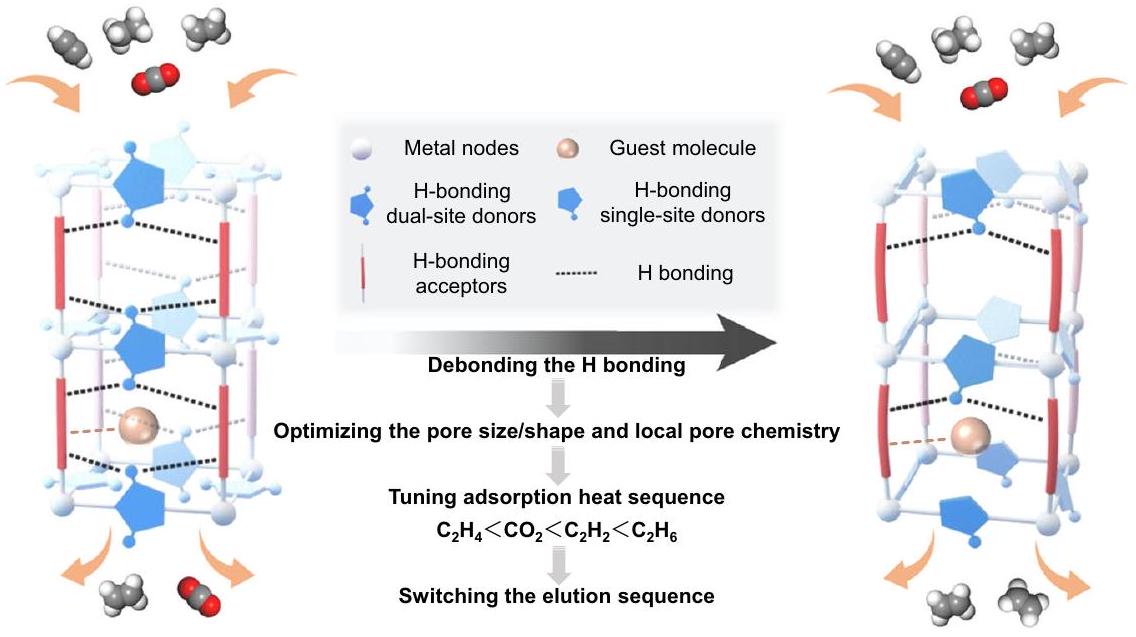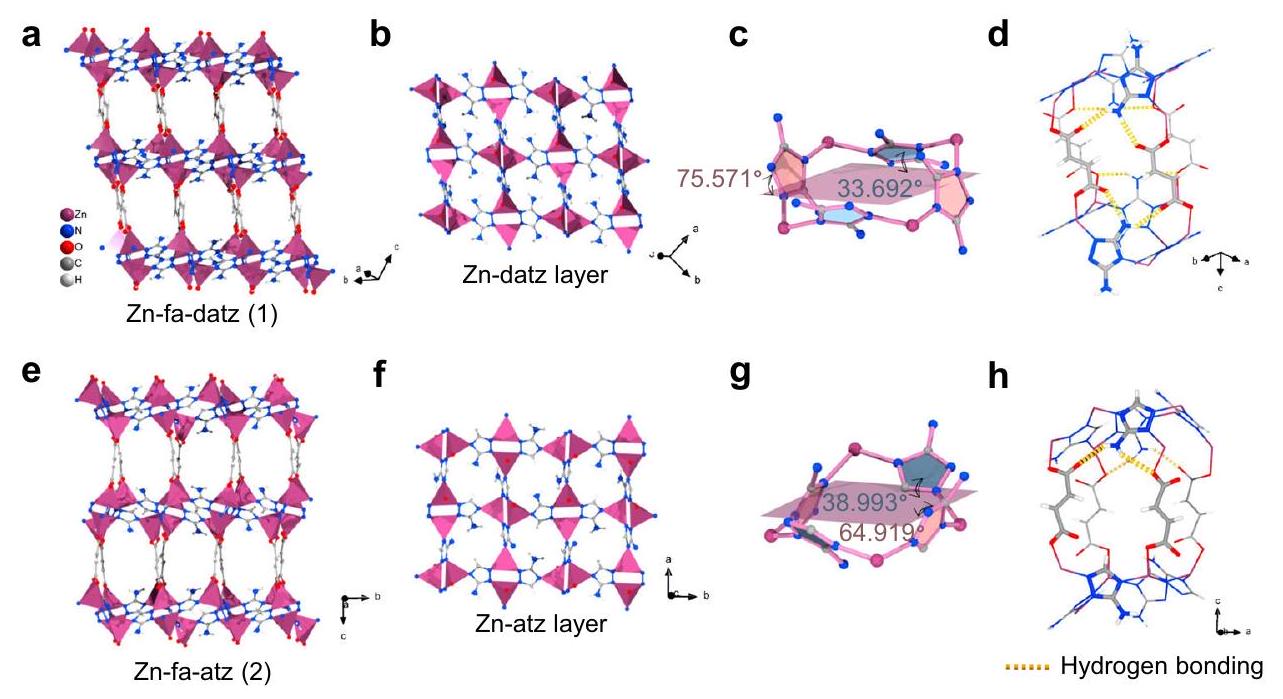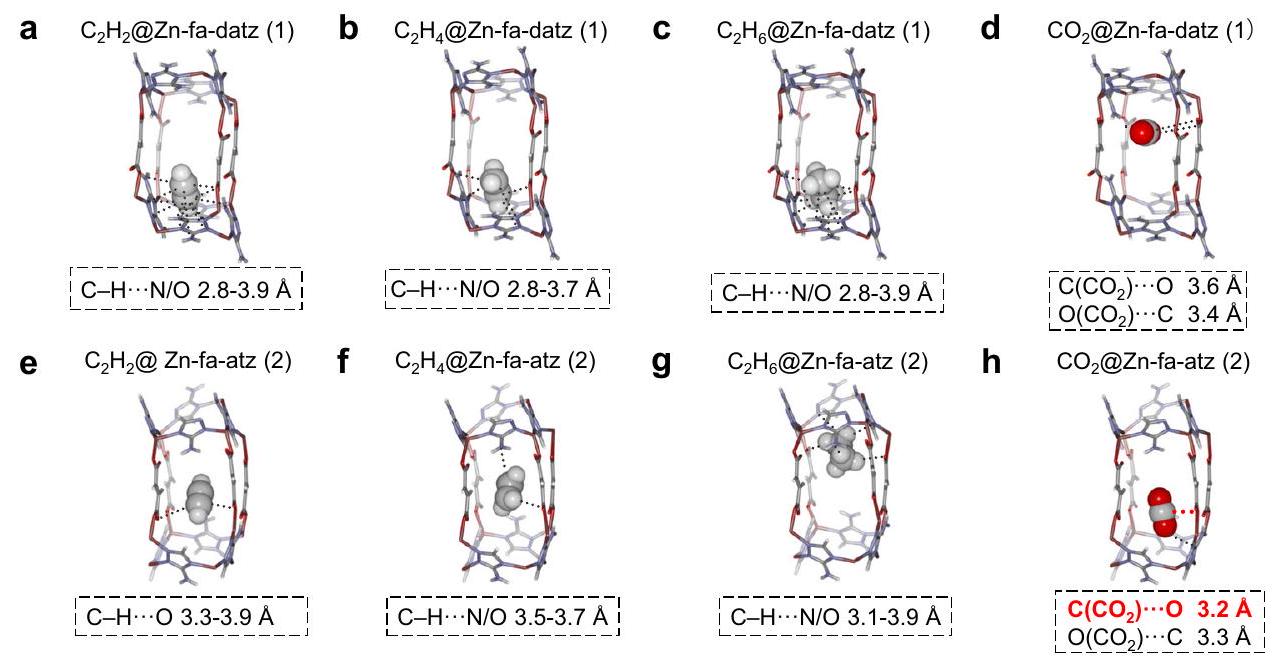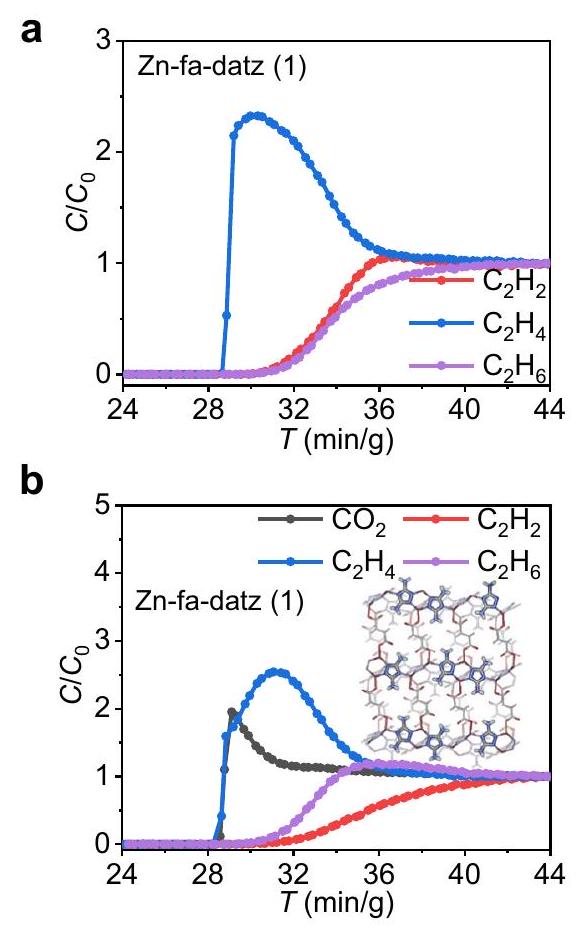DOI: https://doi.org/10.1038/s41467-024-45081-w
PMID: https://pubmed.ncbi.nlm.nih.gov/38280865
تاريخ النشر: 2024-01-27
التحكم في هيكل المسام المدفوع بفك الروابط الهيدروجينية لتغيير وظيفة فصل الغازات متعددة المكونات
تم القبول: 11 يناير 2024
نُشر على الإنترنت: 27 يناير 2024
(أ) التحقق من التحديثات
الملخص
تنقية الإيثيلين
خصائص مع
النتائج
خصائص التركيب والامتصاص لـ Zn-fa-datz (1)
تمت إزالته بشكل تفضيلي مع نقاء عالٍ (99.9%) من ثلاثة غازات في جهاز الامتصاص ذو السرير الثابت (الشكل 5أ)، مما يوضح بشكل أكبر أن Zn -fadatz (1) يمكن أن يحقق تنقية في خطوة واحدة من
تركيب وتوصيف

المتبرعون، باللون الأزرق؛ مستقبلات الروابط الهيدروجينية، باللون الأحمر؛ الروابط الهيدروجينية، خط منقط باللون الأسود؛ التفاعل الضعيف، خط منقط باللون البرتقالي؛ اتجاه تدفق الغاز، صف برتقالي؛ اشتقاق علاقة الهيكل-الوظيفة، صف باللون الأسود).



من مختلف

أداء الامتزاز والفصل لـ
خصائص فيزيائية كيميائية متقاربة جداً. تم مقارنة انتقائيات IAST لـ Zn-fadatz (1) و Zn-fa-atz (2) مع أفضل المواد الممتصة أداءً في الـ
دراسات هيكل المضيف-الضيف


معدل التدفق الكلي لـ
تفاعل (
تجارب الاختراق الديناميكي لكرات Zn-fa-atz (2) وكرات Zn-fa-atz (2)/PES المركبة
يمكن أن تحافظ Zn-fa-atz (2) على تسلسل الإزالة، لكن أوقات الاحتفاظ وشكل منحنيات الاختراق قد تغيرت بشكل كبير، مما يشير إلى الامتزاز التنافسي للماء مع الغازات الأربعة الأخرى (الشكل التكميلية 26).
يظهر خصائص شبه من النوع الأول، مما يدل على الميكروبوروسية للكرات (الأشكال التكميلية 30d و e و 31). تم حساب حجم المسام ليكون
نقاش
طرق
تركيب Zn-fa-datz (1)
تركيب Zn-fa-atz (2)
قياسات امتصاص الغاز
تجارب الاختراق الديناميكية
معدل
ملخص التقرير
توفر البيانات
References
- Yang, Y. et al. Ethylene/ethane separation in a stable hydrogenbonded organic framework through a gating mechanism. Nat. Chem. 13, 933-939 (2021).
- Chen, K. et al. Synergistic sorbent separation for one-step ethylene purification from a four-component mixture. Science 366, 241-246 (2019).
- Bao, Z. et al. Potential of microporous metal-organic frameworks for separation of hydrocarbon mixtures. Energy Environ. Sci. 9, 3612-3641 (2016).
- Ren, T., Patel, M. & Blok, K. Olefins from conventional and heavy feedstocks: energy use in steam cracking and alternative processes. Energy 31, 425-451 (2006).
- Angelini, P. et al. Materials for Separation Technologies: Energy and Emission Reduction Opportunities. (Oak Ridge National Lab. (ORNL), Oak Ridge, TN (United States), 2005).
- Li, J., Kuppler, R. J. & Zhou, H. Selective gas adsorption and separation in metal-organic frameworks. Chem. Soc. Rev. 38, 1477-1504 (2009).
- Zhou, H. & Kitagawa, S. Metal-organic frameworks (MOFs). Chem. Soc. Rev. 43, 5415-5418 (2014).
- Li, H. et al. Porous metal-organic frameworks for gas storage and separation: Status and challenges. EnergyChem 1, 100006 (2019).
- Zhou, D. et al. Adsorptive separation of carbon dioxide: from conventional porous materials to metal-organic frameworks. EnergyChem 1, 100016 (2019).
- Wang, H., Liu, Y. & Li, J. Designer metal-organic frameworks for size-exclusion-based hydrocarbon separations: progress and challenges. Adv. Mater. 32, 2002603 (2020).
- Kitagawa, S., Kitaura, R. & Noro, S. I. Functional porous coordination polymers. Angew. Chem. Int. Ed. 43, 2334-2375 (2004).
- Perry, J. J. IV, Perman, J. A. & Zaworotko, M. J. Design and synthesis of metal-organic frameworks using metal-organic polyhedra as
supermolecular building blocks. Chem. Soc. Rev. 38, 1400-1417 (2009). - Krause, S. et al. A pressure-amplifying framework material with negative gas adsorption transitions. Nature 532, 348-352 (2016).
- Zhou, D. & Zhang, J. On the role of flexibility for adsorptive separation. Acc. Chem. Res. 55, 2966-2977 (2022).
- Zhou, M., El-Sayed, E. S. M., Ju, Z., Wang, W. & Yuan, D. The synthesis and applications of chiral pyrrolidine functionalized metal-organic frameworks and covalent-organic frameworks. Inorg. Chem. Front. 7, 1319-1333 (2020).
- Cui, X. et al. Pore chemistry and size control in hybrid porous materials for acetylene capture from ethylene. Science 353, 141-144 (2016).
- Li, B. et al. An ideal molecular sieve for acetylene removal from ethylene with record selectivity and productivity. Adv. Mater. 29, 1704210 (2017).
- Zhang, Y. et al. Rational design of microporous MOFs with anionic boron cluster functionality and cooperative dihydrogen binding sites for highly selective capture of acetylene. Angew. Chem. Int. Ed. 59, 17664-17669 (2020).
- Zhang, Z. et al. Efficient trapping of trace acetylene from ethylene in an ultramicroporous metal-organic framework: synergistic effect of high-density open metal and electronegative sites. Angew. Chem. Int. Ed. 59, 18927-18932 (2020).
- Dong, Q. et al. Shape- and size-dependent kinetic ethylene sieving from a ternary mixture by a trap-and-flow channel crystal. Adv. Funct. Mater. 32, 2203745 (2022).
- Xue, Y. et al. Precise pore space partitions combined with highdensity hydrogen-bonding acceptors within metal-organic frameworks for highly efficient acetylene storage and separation. Angew. Chem. Int. Ed. 60, 10122-10128 (2021).
- Wang, J. et al. De-linker-enabled exceptional volumetric acetylene storage capacity and benchmark
and separations in metal-organic frameworks. Angew. Chem. Int. Ed. https://doi.org/10.1002/anie. 202217839 (2023). - Shen, J. et al. Simultaneous interlayer and intralayer space control in two-dimensional metal-organic frameworks for acetylene/ethylene separation. Nat. Commun. 11, 6259 (2020).
- Bloch, E. D. et al. Hydrocarbon separations in a metal-organic framework with open iron (II) coordination sites. Science 335, 1606-1610 (2012).
- Liao, P., Zhang, W., Zhang, J. & Chen, X. Efficient purification of ethene by an ethane-trapping metal-organic framework. Nat. Commun. 6, 8697 (2015).
- Li, L. et al. Ethane/ethylene separation in a metal-organic framework with iron-peroxo sites. Science 362, 443-446 (2018).
- Lin, R. et al. Molecular sieving of ethylene from ethane using a rigid metal-organic framework. Nat. Mater. 17, 1128-1133 (2018).
- Gu, C. et al. Design and control of gas diffusion process in a nanoporous soft crystal. Science 363, 387-391 (2019).
- Li, Y. et al. Ultrahigh-uptake capacity-enabled gas separation and fruit preservation by a new single-walled nickel-organic framework. Adv. Sci. 8, 2003141 (2021).
- Wang, G. et al. Boosting ethane/ethylene separation by mofs through the amino-functionalization of pores. Angew. Chem. Int. Ed. 61, e202213015 (2022).
- Geng, S. et al. Scalable room-temperature synthesis of highly robust ethane-selective metal-organic Frameworks for Efficient Ethylene Purification. J. Am. Chem. Soc. 143, 8654-8660 (2021).
- Zhang, J. & Chen, X. Optimized acetylene/carbon dioxide sorption in a dynamic porous crystal. J. Am. Chem. Soc. 131, 5516-5521 (2009).
- Zhang, L. et al. Benchmark
separation in an ultramicroporous metal-organic framework via Copper(I)-alkynyl chemistry. Angew. Chem. Int. Ed. 60, 15995-16002 (2021). - Li, H. et al. An unprecedented pillar-cage fluorinated hybrid porous framework with highly efficient acetylene storage and separation. Angew. Chem. Int. Ed. 60, 7547-7552 (2021).
- Di, Z. et al. Cage-like porous materials with simultaneous high
storage and excellent separation performance. Angew. Chem. Int. Ed. 60, 10828-10832 (2021). - Yang, L. et al. Adsorption site selective occupation strategy within a metal-organic framework for highly efficient sieving acetylene from carbon dioxide. Angew. Chem. Int. Ed. 133, 4620-4624 (2021).
- Reid, C. R. & Thomas, K. M. Adsorption kinetics and size exclusion properties of probe molecules for the selective porosity in a carbon molecular sieve used for air separation. J. Phys. Chem. B 105, 10619-10629 (2001).
- Sircar, S. Basic research needs for design of adsorptive gas separation processes. Ind. Eng. Chem. Res. 45, 5435-5448 (2006).
- Eguchi, R., Uchida, S. & Mizuno, N. Inverse and High
sorption selectivity in flexible organic-inorganic ionic crystals. Angew. Chem. Int. Ed. 51, 1635-1639 (2012). - Hao, H. et al. Simultaneous trapping of
and from a ternary mixture of in a robust metal-organic framework for the purification of . Angew. Chem. Int. Ed. 130, 16299-16303 (2018). - Wang, Y. et al. One-step ethylene purification from an acetylene/ ethylene/ethane ternary mixture by cyclopentadiene cobaltfunctionalized metal-organic frameworks. Angew. Chem. Int. Ed. 60, 11350-11358 (2021).
- Wang, G. et al. One-step
purification from ternary mixtures by a robust metal-organic framework with customized pore environment. Angew. Chem. Int. Ed. 61, https://doi.org/ 10.1002/anie. 202205427 (2022). - Gu, X. et al. Immobilization of lewis basic sites into a stable ethaneselective MOF enabling one-step separation of ethylene from a ternary mixture. J. Am. Chem. Soc. 144, 2614-2623 (2022).
- Yang, S. et al. Efficient purification of ethylene from C2 hydrocarbons with an
-selective metal-organic framework. ACS Appl. Mater. Interfaces 13, 962-969 (2021). - Jiang, Z. et al. An aromatic-rich cage-based MOF with inorganic chloride ions decorating the pore surface displaying the preferential adsorption of C 2 H 2 and C 2 H 6 over C 2 H 4 . Inorg. Chem. Front. 8, 1243-1252 (2021).
- Fan, L. et al. Rational construction and performance regulation of an In(III)-tetraisophthalate framework for one-step adsorption-phase purification of
from hydrocarbons. Inorg. Chem. 60, 10819-10829 (2021). - Xu, Z. et al. A robust Th-azole framework for highly efficient purification of
from a mixture. Nat. Commun. 11, 3163 (2020). - Zhang, P. et al. Synergistic binding sites in a hybrid ultramicroporous material for one-step ethylene purification from ternary C(2) hydrocarbon mixtures. Sci. Adv. 8, https://doi.org/10.1126/ sciadv.abn9231 (2022)
- Cao, J. et al. One-step ethylene production from a four-component gas mixture by a single physisorbent. Nat. Commun. 12, 6507 (2021).
- Laha, S. et al. Tailoring Robust Al-MOF for Trapping
and towards Efficient purification from quaternary mixtures. Chem. Sci. 13, 7172-7180 (2022). - Zhang, T. et al. General pore features for one-step
production from a C2 hydrocarbon mixture. Chem. Commun. 58, 4954-4957 (2022). - Xing, G., Liu, Q., Zhang, Y., Zhang, S. & Dong, Y. Microporous Zinc (II) metal-organic framework with 6-Connected pcu topology: synthesis, structure, and gas adsorption properties. Z. Anorg. Allg. Chem. 641, 1556-1559 (2015).
- Mukherjee, S., Sensharma, D., Chen, K. & Zaworotko, M. Crystal engineering of porous coordination networks to enable separation of C2 hydrocarbons. Chem. Commun. 56, 10419-10441 (2020).
- Spek, A. L. Single-crystal structure validation with the program PLATON. J. Appl. Crystallogr. 36, 7-13 (2003).
- Bondi, A. Van der Waals volumes and radii. J. Phys. Chem. 68, 441-451 (1964).
- Wang, Y. et al. Selective aerobic oxidation of a metal-organic framework boosts thermodynamic and kinetic propylene/propane selectivity. Angew. Chem. Int. Ed. 58, 7692-7696 (2019).
- Zhang, X. W. et al. Tuning the gating energy barrier of metal-organic framework for molecular sieving. Chem 7, 1006-1019 (2021).
- Ye, Z. M. et al. A hydrogen-bonded yet hydrophobic porous molecular crystal for molecular-sieving-like separation of butane and isobutane. Angew. Chem. Int. Ed. 59, 23322-23328 (2020).
- Fletcher, A. J. et al. Adsorption dynamics of gases and vapors on the nanoporous metal organic framework material
: guest modification of host sorption behavior. J. Am. Chem. Soc. 123, 10001-10011 (2001). - Yang, R. et al. Source data of Zn-fa-datz (1) and Zn-fa-atz (2) that support the findings of this study. Data sets. figshare https://doi. org/10.6084/m9.figshare. 24864540 (2023).
- Dubbeldam, D., Calero, S. & Vlugt, T. J. iRASPA: GPU-accelerated visualization software for materials scientists. Mol. Simulat. 44, 653-676 (2018).
شكر وتقدير
مساهمات المؤلفين
جمع T.G. بيانات SEM. قام R.Y. و Y.W. بتحليل بيانات الامتزاز وبيانات الاختراق التجريبية. قام Y.W. و B.-K.L. و T.Z. بتحليل بيانات البلورة المفردة، وجمع Y.W. و Z.-M.Y. وتحليل بيانات تنقيح المسحوق. كتب Y.W. و R.Y. و K.-J.C. الورقة، وساهم جميع المؤلفين في مراجعة المخطوطة.
المصالح المتنافسة
معلومات إضافية
المواد التكميلية متاحة على
https://doi.org/10.1038/s41467-024-45081-w.
http://www.nature.com/reprints
© المؤلف(ون) 2024
المختبر الرئيسي للمواد البوليمرية الخاصة والذكية التابعة لوزارة الصناعة وتكنولوجيا المعلومات، مختبر شيان الرئيسي للمواد العضوية المسامية الوظيفية، كلية الكيمياء والهندسة الكيميائية، جامعة شمال غرب البوليتكنيك، شيان، شنشي 710072، جمهورية الصين الشعبية. مختبر فوجيان الرئيسي لمواد البوليمر، كلية الكيمياء وعلوم المواد، جامعة فوجيان نورمال، فوزهو 350007، جمهورية الصين الشعبية. قسم الكيمياء، جامعة جنوب فلوريدا، تامبا، فلوريدا، الولايات المتحدة الأمريكية. معهد فان ‘ت هوف للعلوم الجزيئية، جامعة أمستردام، حديقة العلوم 904، 1098 XH أمستردام، هولندا. مختبر شاندونغ الرئيسي للطاقة الغازية الفعالة والنظيفة، كلية الهندسة الكيميائية والتكنولوجيا، جامعة تاييوان للتكنولوجيا، تاييوان 030024، جمهورية الصين الشعبية. ساهم هؤلاء المؤلفون بالتساوي: رونغ يانغ، يو وانغ. البريد الإلكتروني: ckjiscon@nwpu.edu.cn
DOI: https://doi.org/10.1038/s41467-024-45081-w
PMID: https://pubmed.ncbi.nlm.nih.gov/38280865
Publication Date: 2024-01-27
Hydrogen bond unlocking-driven pore structure control for shifting multicomponent gas separation function
Accepted: 11 January 2024
Published online: 27 January 2024
(A) Check for updates
Abstract
Purification of ethylene (
properties with
Results
Structure and adsorption properties of Zn-fa-datz (1)
eluted preferentially with high purity (99.9%) from three gases in the fixed-bed adsorber (Fig. 5a), thus further demonstrating that Zn -fadatz (1) can achieve one-step purification of
Synthesis and characterization of

donors, blue; H-bonding acceptors, red; H bonding, black dotted line; weak interaction, orange dotted line; the direction of gas flow, orange row; derivation of structure-function relationship, black row).



from different

Adsorption and separation performances of
very close physicochemical properties. The IAST selectivities of Zn-fadatz (1) and Zn -fa-atz (2) were compared with the best-performing sorbents in the
Host-guest structure studies


total flowing rate of
interaction (
Dynamic breakthrough experiments of Zn-fa-atz (2) and Zn-fa-atz (2)/PES composite beads
that Zn-fa-atz (2) can maintain the elution sequence, but the retention times and the shape of the breakthrough curves have changed significantly, indicating the competitive adsorption of water with the other four gases (Supplementary Fig. 26).
shows a quasi-type-I characteristic, indicating the microporosity of the beads (Supplementary Figs. 30d, e and 31). The pore volume was calculated to be
Discussion
Methods
Synthesis of Zn-fa-datz (1)
Synthesis of Zn-fa-atz (2)
Gas adsorption measurements
Dynamic breakthrough experiments
rate of
Reporting summary
Data availability
References
- Yang, Y. et al. Ethylene/ethane separation in a stable hydrogenbonded organic framework through a gating mechanism. Nat. Chem. 13, 933-939 (2021).
- Chen, K. et al. Synergistic sorbent separation for one-step ethylene purification from a four-component mixture. Science 366, 241-246 (2019).
- Bao, Z. et al. Potential of microporous metal-organic frameworks for separation of hydrocarbon mixtures. Energy Environ. Sci. 9, 3612-3641 (2016).
- Ren, T., Patel, M. & Blok, K. Olefins from conventional and heavy feedstocks: energy use in steam cracking and alternative processes. Energy 31, 425-451 (2006).
- Angelini, P. et al. Materials for Separation Technologies: Energy and Emission Reduction Opportunities. (Oak Ridge National Lab. (ORNL), Oak Ridge, TN (United States), 2005).
- Li, J., Kuppler, R. J. & Zhou, H. Selective gas adsorption and separation in metal-organic frameworks. Chem. Soc. Rev. 38, 1477-1504 (2009).
- Zhou, H. & Kitagawa, S. Metal-organic frameworks (MOFs). Chem. Soc. Rev. 43, 5415-5418 (2014).
- Li, H. et al. Porous metal-organic frameworks for gas storage and separation: Status and challenges. EnergyChem 1, 100006 (2019).
- Zhou, D. et al. Adsorptive separation of carbon dioxide: from conventional porous materials to metal-organic frameworks. EnergyChem 1, 100016 (2019).
- Wang, H., Liu, Y. & Li, J. Designer metal-organic frameworks for size-exclusion-based hydrocarbon separations: progress and challenges. Adv. Mater. 32, 2002603 (2020).
- Kitagawa, S., Kitaura, R. & Noro, S. I. Functional porous coordination polymers. Angew. Chem. Int. Ed. 43, 2334-2375 (2004).
- Perry, J. J. IV, Perman, J. A. & Zaworotko, M. J. Design and synthesis of metal-organic frameworks using metal-organic polyhedra as
supermolecular building blocks. Chem. Soc. Rev. 38, 1400-1417 (2009). - Krause, S. et al. A pressure-amplifying framework material with negative gas adsorption transitions. Nature 532, 348-352 (2016).
- Zhou, D. & Zhang, J. On the role of flexibility for adsorptive separation. Acc. Chem. Res. 55, 2966-2977 (2022).
- Zhou, M., El-Sayed, E. S. M., Ju, Z., Wang, W. & Yuan, D. The synthesis and applications of chiral pyrrolidine functionalized metal-organic frameworks and covalent-organic frameworks. Inorg. Chem. Front. 7, 1319-1333 (2020).
- Cui, X. et al. Pore chemistry and size control in hybrid porous materials for acetylene capture from ethylene. Science 353, 141-144 (2016).
- Li, B. et al. An ideal molecular sieve for acetylene removal from ethylene with record selectivity and productivity. Adv. Mater. 29, 1704210 (2017).
- Zhang, Y. et al. Rational design of microporous MOFs with anionic boron cluster functionality and cooperative dihydrogen binding sites for highly selective capture of acetylene. Angew. Chem. Int. Ed. 59, 17664-17669 (2020).
- Zhang, Z. et al. Efficient trapping of trace acetylene from ethylene in an ultramicroporous metal-organic framework: synergistic effect of high-density open metal and electronegative sites. Angew. Chem. Int. Ed. 59, 18927-18932 (2020).
- Dong, Q. et al. Shape- and size-dependent kinetic ethylene sieving from a ternary mixture by a trap-and-flow channel crystal. Adv. Funct. Mater. 32, 2203745 (2022).
- Xue, Y. et al. Precise pore space partitions combined with highdensity hydrogen-bonding acceptors within metal-organic frameworks for highly efficient acetylene storage and separation. Angew. Chem. Int. Ed. 60, 10122-10128 (2021).
- Wang, J. et al. De-linker-enabled exceptional volumetric acetylene storage capacity and benchmark
and separations in metal-organic frameworks. Angew. Chem. Int. Ed. https://doi.org/10.1002/anie. 202217839 (2023). - Shen, J. et al. Simultaneous interlayer and intralayer space control in two-dimensional metal-organic frameworks for acetylene/ethylene separation. Nat. Commun. 11, 6259 (2020).
- Bloch, E. D. et al. Hydrocarbon separations in a metal-organic framework with open iron (II) coordination sites. Science 335, 1606-1610 (2012).
- Liao, P., Zhang, W., Zhang, J. & Chen, X. Efficient purification of ethene by an ethane-trapping metal-organic framework. Nat. Commun. 6, 8697 (2015).
- Li, L. et al. Ethane/ethylene separation in a metal-organic framework with iron-peroxo sites. Science 362, 443-446 (2018).
- Lin, R. et al. Molecular sieving of ethylene from ethane using a rigid metal-organic framework. Nat. Mater. 17, 1128-1133 (2018).
- Gu, C. et al. Design and control of gas diffusion process in a nanoporous soft crystal. Science 363, 387-391 (2019).
- Li, Y. et al. Ultrahigh-uptake capacity-enabled gas separation and fruit preservation by a new single-walled nickel-organic framework. Adv. Sci. 8, 2003141 (2021).
- Wang, G. et al. Boosting ethane/ethylene separation by mofs through the amino-functionalization of pores. Angew. Chem. Int. Ed. 61, e202213015 (2022).
- Geng, S. et al. Scalable room-temperature synthesis of highly robust ethane-selective metal-organic Frameworks for Efficient Ethylene Purification. J. Am. Chem. Soc. 143, 8654-8660 (2021).
- Zhang, J. & Chen, X. Optimized acetylene/carbon dioxide sorption in a dynamic porous crystal. J. Am. Chem. Soc. 131, 5516-5521 (2009).
- Zhang, L. et al. Benchmark
separation in an ultramicroporous metal-organic framework via Copper(I)-alkynyl chemistry. Angew. Chem. Int. Ed. 60, 15995-16002 (2021). - Li, H. et al. An unprecedented pillar-cage fluorinated hybrid porous framework with highly efficient acetylene storage and separation. Angew. Chem. Int. Ed. 60, 7547-7552 (2021).
- Di, Z. et al. Cage-like porous materials with simultaneous high
storage and excellent separation performance. Angew. Chem. Int. Ed. 60, 10828-10832 (2021). - Yang, L. et al. Adsorption site selective occupation strategy within a metal-organic framework for highly efficient sieving acetylene from carbon dioxide. Angew. Chem. Int. Ed. 133, 4620-4624 (2021).
- Reid, C. R. & Thomas, K. M. Adsorption kinetics and size exclusion properties of probe molecules for the selective porosity in a carbon molecular sieve used for air separation. J. Phys. Chem. B 105, 10619-10629 (2001).
- Sircar, S. Basic research needs for design of adsorptive gas separation processes. Ind. Eng. Chem. Res. 45, 5435-5448 (2006).
- Eguchi, R., Uchida, S. & Mizuno, N. Inverse and High
sorption selectivity in flexible organic-inorganic ionic crystals. Angew. Chem. Int. Ed. 51, 1635-1639 (2012). - Hao, H. et al. Simultaneous trapping of
and from a ternary mixture of in a robust metal-organic framework for the purification of . Angew. Chem. Int. Ed. 130, 16299-16303 (2018). - Wang, Y. et al. One-step ethylene purification from an acetylene/ ethylene/ethane ternary mixture by cyclopentadiene cobaltfunctionalized metal-organic frameworks. Angew. Chem. Int. Ed. 60, 11350-11358 (2021).
- Wang, G. et al. One-step
purification from ternary mixtures by a robust metal-organic framework with customized pore environment. Angew. Chem. Int. Ed. 61, https://doi.org/ 10.1002/anie. 202205427 (2022). - Gu, X. et al. Immobilization of lewis basic sites into a stable ethaneselective MOF enabling one-step separation of ethylene from a ternary mixture. J. Am. Chem. Soc. 144, 2614-2623 (2022).
- Yang, S. et al. Efficient purification of ethylene from C2 hydrocarbons with an
-selective metal-organic framework. ACS Appl. Mater. Interfaces 13, 962-969 (2021). - Jiang, Z. et al. An aromatic-rich cage-based MOF with inorganic chloride ions decorating the pore surface displaying the preferential adsorption of C 2 H 2 and C 2 H 6 over C 2 H 4 . Inorg. Chem. Front. 8, 1243-1252 (2021).
- Fan, L. et al. Rational construction and performance regulation of an In(III)-tetraisophthalate framework for one-step adsorption-phase purification of
from hydrocarbons. Inorg. Chem. 60, 10819-10829 (2021). - Xu, Z. et al. A robust Th-azole framework for highly efficient purification of
from a mixture. Nat. Commun. 11, 3163 (2020). - Zhang, P. et al. Synergistic binding sites in a hybrid ultramicroporous material for one-step ethylene purification from ternary C(2) hydrocarbon mixtures. Sci. Adv. 8, https://doi.org/10.1126/ sciadv.abn9231 (2022)
- Cao, J. et al. One-step ethylene production from a four-component gas mixture by a single physisorbent. Nat. Commun. 12, 6507 (2021).
- Laha, S. et al. Tailoring Robust Al-MOF for Trapping
and towards Efficient purification from quaternary mixtures. Chem. Sci. 13, 7172-7180 (2022). - Zhang, T. et al. General pore features for one-step
production from a C2 hydrocarbon mixture. Chem. Commun. 58, 4954-4957 (2022). - Xing, G., Liu, Q., Zhang, Y., Zhang, S. & Dong, Y. Microporous Zinc (II) metal-organic framework with 6-Connected pcu topology: synthesis, structure, and gas adsorption properties. Z. Anorg. Allg. Chem. 641, 1556-1559 (2015).
- Mukherjee, S., Sensharma, D., Chen, K. & Zaworotko, M. Crystal engineering of porous coordination networks to enable separation of C2 hydrocarbons. Chem. Commun. 56, 10419-10441 (2020).
- Spek, A. L. Single-crystal structure validation with the program PLATON. J. Appl. Crystallogr. 36, 7-13 (2003).
- Bondi, A. Van der Waals volumes and radii. J. Phys. Chem. 68, 441-451 (1964).
- Wang, Y. et al. Selective aerobic oxidation of a metal-organic framework boosts thermodynamic and kinetic propylene/propane selectivity. Angew. Chem. Int. Ed. 58, 7692-7696 (2019).
- Zhang, X. W. et al. Tuning the gating energy barrier of metal-organic framework for molecular sieving. Chem 7, 1006-1019 (2021).
- Ye, Z. M. et al. A hydrogen-bonded yet hydrophobic porous molecular crystal for molecular-sieving-like separation of butane and isobutane. Angew. Chem. Int. Ed. 59, 23322-23328 (2020).
- Fletcher, A. J. et al. Adsorption dynamics of gases and vapors on the nanoporous metal organic framework material
: guest modification of host sorption behavior. J. Am. Chem. Soc. 123, 10001-10011 (2001). - Yang, R. et al. Source data of Zn-fa-datz (1) and Zn-fa-atz (2) that support the findings of this study. Data sets. figshare https://doi. org/10.6084/m9.figshare. 24864540 (2023).
- Dubbeldam, D., Calero, S. & Vlugt, T. J. iRASPA: GPU-accelerated visualization software for materials scientists. Mol. Simulat. 44, 653-676 (2018).
Acknowledgements
Author contributions
T.G. collected the SEM data. R.Y. and Y.W. analyzed the adsorption data and experimental breakthrough data. Y.W., B.-K.L. and T.Z. analyzed the single crystal data, Y.W. and Z.-M.Y. collected and analyzed the powder refinement data. Y.W., R.Y. and K.-J.C. wrote the paper, and all authors contributed to revise the manuscript.
Competing interests
Additional information
supplementary material available at
https://doi.org/10.1038/s41467-024-45081-w.
http://www.nature.com/reprints
© The Author(s) 2024
Key Laboratory of Special Functional and Smart Polymer Materials of Ministry of Industry and Information Technology, Xi’an Key Laboratory of Functional Organic Porous Materials, School of Chemistry and Chemical Engineering, Northwestern Polytechnical University, Xi’an, Shaanxi 710072, PR China. Fujian Key Laboratory of Polymer Materials, College of Chemistry and Materials Science, Fujian Normal University, Fuzhou 350007, PR China. Department of Chemistry, University of South Florida, Tampa, FL, USA. Van ‘t Hoff Institute for Molecular Sciences, University of Amsterdam, Science Park 904, 1098 XH Amsterdam, The Netherlands. Shanxi Key Laboratory of Gas Energy Efficient and Clean Utilization, College of Chemical Engineering and Technology, Taiyuan University of Technology, Taiyuan 030024, PR China. These authors contributed equally: Rong Yang, Yu Wang. e-mail: ckjiscon@nwpu.edu.cn
